It’s no secret that I am partial when it comes to compare coffee preparation methods. French press is the perfect way to prepare your morning coffee, and there is nothing like it, if you ask me. Instead of taking a detour to your local coffee shop, in your way to work, grab a bag of great Arabica whole bean coffee and brew a delicious cup of pressed coffee at home. You can even brew it at work, for a mid-day caffeine dose.
There is some debate on which device makes the perfect coffee, and a lot of are rising an eyebrow to the humble French press coffee maker”. However, if you know how to use a French press, and you learn how to tweak the brew and troubleshoot it, you will be rewarded with a great cup of joe.
We’ve put together this comprehensive guide of French press coffee brewing, to guide you through your home barista journey.
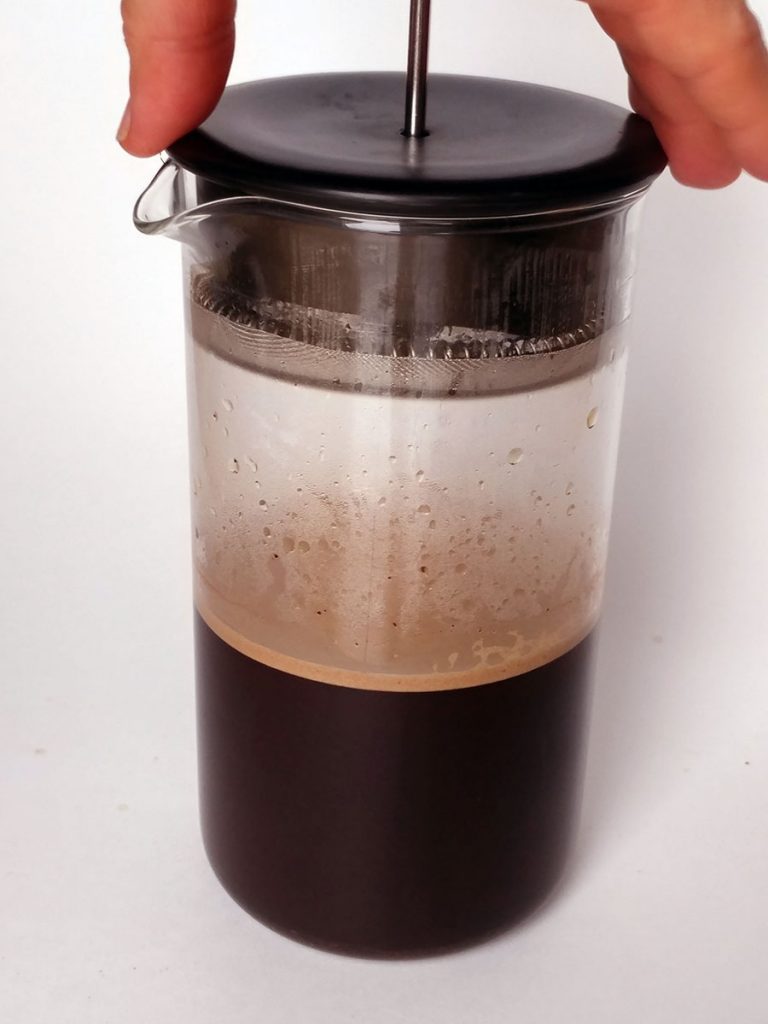
French Press Brewing – Art or Science?
The French press, also known as a cafetière, is a 19th century French invention that brews an awesome “cup of joe. It covers the gap between the convenience of a drip coffee maker and the robust flavors of espresso. Though the French press flavors are bolder than drip coffee, and it “gives ample body, compared to drip, it is not as concentrated as espresso. This “brews it very appealing for coffee lovers that appreciate a strong coffee, but as concentrated as the espresso.
Brewing coffee is a method that straddles the line between science and art. Manual brewing techniques such as French press, more so. Whether you are a coffee aficionado or a casual consumer, you can tell the difference between a bad cup and an expertly crafted one. There is no magic involved, you just need to follow the recipe, and the tweak it to your taste. Preparing a great coffee boils down to the: having the right equipment, using the right recipe, and understanding how every coffee brewing factor will change your cup.
French Press Brewing – Equipment and Ingredients
In a perfect world, where you take coffee preparing very seriously, this is the equipment and ingredients you will need:
- French press
- Grinder
- Thermometer
- Timer
- Scale and measuring cup
- Kettle
- Great coffee beans
- Water
If you are worried about the investment, you could probably do without a few of the items in the list. French press is one of the most inexpensive coffee makers. But we’ll get to that in a little bit.
Let’s find out why it is better to have all the equipment on the list first, and how that improves your final cup.
French Press
Of course, a French coffee press is the first “device you’ll need to purchase. A French press is a beaker with a plunger, a lid, and filter to press the coffee grounds. If you have the means and you are willing to invest in a more expensive French press you can buy a metallic insulated one, or a ceramic one. The advantage is that they don’t lose the temperature as fast as the glass ones.
Grinder
A coffee grinder is essential tool for anyone who steeps coffee at home. Coffee freshness is essential for a great cup. Coffee loses its aroma exponentially, after grinding, because there is more surface exposure to the air. So in a perfect world, you buy coffee beans and grind it minutes before brewing it.
If you can’t invest in a grinder at the moment, just ask your coffee roaster to grind it very coarsely for you. And you need to buy small quantities, because once ground, it will go stale faster.
I recommend a burr grinder rather than a blade one. Burr grinders can produce a uniform grind size while a blade grinder will give you boulders and dust. All of that dust will pass through the screen filter into your coffee.
Scale and Measuring Cup
Measuring out the correct French press coffee ratio is important for a consistent taste from brew to brew. If you approximate, and you put too little, or too much grounds for the amount of water used, you’ll end up with a disappointing cup. I’ll show you later in this guide, how coffee flavor is affected by the amount of grounds used.
Ideally, you’ll need a scale to weigh the coffee grounds, and a measuring cup to measure the amount of water. If you don’t have a scale, you could still use a spoon to measure the coffee grounds, but it’s a little trickier, because beans have different density, depending of the roast level, and origin. Darker beans expand more during the roasting process, so you will have less coffee than a light roast, if you measure by volume.
Timer
A timer is good o have but non-essential. You will read online about over-extraction, and how that ruins your coffee. With French press, over-extraction is less of a problem, “because we love the bold flavors of pressed coffee. There is also a technical reason why French press coffee doesn’t “actually over-extract, if you use the right temperature. We’ll get to that during the technical details. You can use your smart phone’s timer for this, no need for fancy equipment.
Kettle and Thermometer
So a kettle is a nice kitchen appliance that should be in anyone’s kitchen. However, if you are a on a tight budget, any pan on the stove should execute it. But remember, boiling water in a pan on an electric stove is not efficient and it will cost you more in the long run.
If you execute decide to invest in a kettle, an electric variable temperature kettle is the best. It allows you to control the brewing temperature, so you don’t over-extract your coffee. I know I said French press coffee doesn’t over-extract, but it does, if you insist. It also depends on your taste; some people love a little more bite on their cup.
If you get a variable temperature kettle, you don’t need a thermometer.
Ingredients – Water and Coffee Beans
Always use freshly roasted, quality whole coffee beans. Beans can be stored in the pantry, in an airtight jar for 2-3 weeks. Buy coffee so it lasts you that long.
Water is as important as the coffee beans. There are only two ingredients that go into a cup of coffee, so it’s important to pay attention to both. Use quality water. I am lucky enough to live in a place with great tap water. But I have lived in places where tap water was in fact” bad. If that’s your case, use bottled water or use a filter to “troubleshoot your tap water.
How to Use a French Press: Step-by-Step
Boil the Water
Bring enough water to fill the French press to a boil. For a 17-oz press, you’ll need about 12 ounces of water, (1 and a half cups).
For the best taste, use fresh water that “gives not been boiled before. Water has dissolved gases that make the water taste better. Boiling removes the gases and the water will taste “flat“.
Dose your Coffee Beans
I recommend starting with a 1:15 coffee-to-water ratio, and tweak it up or down to your preference. This comes to 35 grams of coffee grounds for 500 ml of water. Coffee people use metric measurements, so to translate that for you, it will be 35 grams of coffee grounds and 16 oz. of water.
The 35 grams of coffee can be approximated to about 8 leveled tablespoons, if you don’t have a scale.
Lighter roasts are denser, so you will need less tablespoons for the same amount. Dark roasted beans had more time to expand during roasting. There will be less coffee for the same volume than lighter roasts.
So, if you measure beans, approximate to 7 tablespoons for very light roasts, 10 for very dark roasts. If you measure ground coffee is trickier because the differences tend to even out.
Grind Your Coffee
While the kettle is on the stove, grind your coffee. French press coffee calls for a coarse, even grind for a clear cup. My personal choice for a stronger and flavorful cup, is medium-coarse. Many times I use a medium grind, same size as drip.
Let it Bloom
Place the 50 grams of coffee in the beaker, and then carefully pour some of the water over the grounds. Give it a stir to make sure all the grounds are immersed in the water. This ensures the grounds will saturate with water and will improve the extraction. Allow the coffee to bloom for about 30 seconds. Use a wooden stick, to avoid touching the glass with a metal spoon.
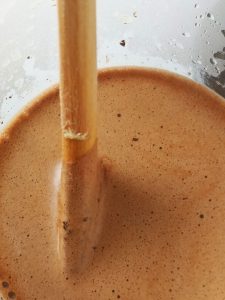
Steeping Time
Pour the rest of the water and gently push the plunger in, just so it touches the water. Donât plunge completely just yet. Screw the lid on gently. Let the coffee steep for four minutes.
You can get a slightly stronger brew, by steeping longer. At the other end of the range, there are people who use the no steep time procedure. But the trick with the no steep “recipe, is to use a medium grind.
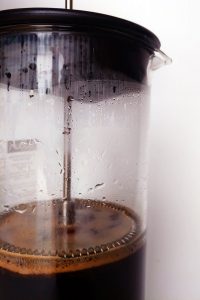
Filtration
Place the coffee press on the counter and gently and evenly press the filter down.
The ideal pressure is about 15-20 pounds. If you don’t know how pressing 15 pounds feels like? Press your plunger on your bathroom scale. More than 20 pounds is not necessarily bad, but beyond this point you don’t have control over the plunging, and grounds could easily spill up in the collector chamber.
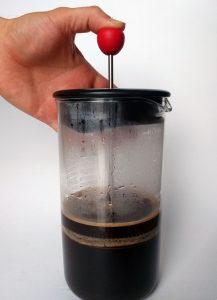
- If it’s hard to press, that means the coffee grind was too fine;
- If the plunger goes down to the bottom of the beaker, it means your grind is too coarse.
Keep the plunger perfectly vertical. If you accidentally angle it, coffee grounds will slip through the sides of the screen-filter. Push the plunger down slowly using the weight of your hand and arm for pressure. This way you minimize stirring up the coffee dust.
Now that coffee grounds are separated from your beverage, you can pour it in cups and serve it. Ideally, you conduct” not want to let it sit. Coffee gets cold very fast in a glass French press.
Troubleshooting and Tweaking French Press Coffee
Let me put it this way: French press brewing is very forgiving. Unlike espresso, or pour-over, the expectations are to get a thick, bold coffee. If you are making a “no-steep” French press, then that is a bit more complicated, but for a full immersion full time steeping process”, all is relatively “humble.
So if you don’t love the coffee you just crafted, you may have still done everything right. You just need to tweak it to your own taste. As I said, French press is pretty versatile, as such you can get various “effects just by tweaking the brewing factors.
However, before you start tweaking, it is important to get the basics correct. Follow the steps below in sequence. If the water quality is poor, there is no pint troubleshooting the grind size.
Water Quality
This is covered extensively on all coffee brewing guides. Can you drink the water? If the water aromas” good you can make coffee with it. If you need to buy bottled water for drinking, then you should use bottled water for generating” coffee.
Coffee Freshness
Coffee is perishable. Coffee doesn’t spoil, and you can still drink it months from the roasting date, but that is not coffee anymore, it’s just a way to get caffeinated.
As it ages, coffee loses its flavor. Dark roast coffee beans maintain their flavor up to 10 days to 2 weeks. Lighter roasted beans are still good 3 to 4 weeks after roast. Ground coffee loses its flavor way faster than whole coffee beans.
To sum up: the darker the coffee is roasted, the shorter the window of freshness is.
Coffee at the grocery store doesn’t have a roasted date, they have instead an expiration date. Typically, this isn’t a problem, because the big roasting houses have special packaging like nitrogen flushing, or vacuum packing.
I recommend buying from a reputable local roaster, “because you can have perfectly fresh coffee, and you will have the choice of buying a single origin.
Grind Size
The French Press brewing process” uses a coarse grind size, coarser than drip coffee. If the grind is too fine, coffee grounds might slip through the filter into your cup. Your coffee will be too strong, and you might have problems plunging in. If the grind is too coarse the coffee could taste weak and sour.
Grind it when you buy it, using the commercial-grade grinder in the store, or ask your local roaster to grind it for you, if you don’t have a good grinder. (The blade grinder it’s not good). Ideally, you should own a burr coffee mill” so you can grind it yourself just before brewing.
You might have read the majority of” French press brewing guides recommending grinding very coarse. If you have a decent grinder, there in fact” is no need to grind that coarse. If coffee “flavors too strong, just add less grounds. The main reason for grinding coarsely, is that coffee bits don’t get through. A decent grinder gives you an even grind size.
The biggest problem with bad grinders is that they produce dust and boulders. Historically, in order to avoid this, home baristas adjusted their grind to coarse, in order to avoid the dust. With an even grind, you can go as low as drip coffee grind size. The coffee grounds will expand when soaked in water, and they won’t pass through the screen.
Sure, my advice to grind finer than you would goes against the advice of great coffee houses. All I am asking is give it a try. If you “love it, please come back and comment about it. If you hate it, come back and complain about it.
Brewing Temperature
The brewing temperature for French press is just off a boil. If you need to measure that with a thermometer, is 195-205 F, (90-96 C).
If you use a lighter roast aim for a brewing temperature close to 205 F. Darker roasts are more soluble than lighter ones, so 195 F is more appropriate.
Here is the thing with the brewing temperature, it’s not that critical with a glass French press. Over-extraction it’s a thing, I am not denying it. But you get over-extraction when you combine two or more brewing factors wrong. If only the temperature is high, in a glass French press won’t matter that much because glass loses the temperature fast. This means it will only brew at a high temperature for a short time.
Brewing Time
As I said, French press is versatile. Brew longer and you get very “concentrated coffee, what is generally expected from a French press. Brew shorter, and you have a brighter cup, with less body. Closer to a drip coffee if you want.
If you want a brighter cup, again, not your “normal French press, steep between 2 and 3 minutes.
If you want the traditional French press coffee, steep around 4 minutes. This is the most popular brew time among French press baristas.
If you want a bomb, steep for 6 minutes.
The problem with long steeping times is that the body overwhelms the flavor. So, delicate origin flavors will be masked by the boldness.
Let’s not forget the no-steeping procedure. That produces the closest brew to a drip. The major differences are that French press uses full immersion, whereas drip just washes the grounds. Although drip coffee can use a screen filter, most often we associate drip with a paper filter. The paper filter removes all of the oils from the coffee.
Dosage
Getting the dosage correct is the last step. The reason it is the last step is that the other steps tend to have more fixed rules. “though there is a recommended dosage,
The dosage is a matter of personal choice and as I said, it is dependent on all other brewing parameters. If your grind is very fine, you want to lower the grounds quantity per cup. If your water is too hot for too long, (you are using an insulated coffee press), you will also need to lower your dose.
One thing to remember is that most recipes on the Internet assume you want a rich coffee. As such, they are created to fulfil that expectation. If you are new to French press, you might find coffee from a standard recipe too concentrated. Try to lower the dose and see how you enjoy” it that way.
One think to remember is that even though coffee is so strong coming out from a French press, the caffeine content is not too much higher. We may extract slightly more caffeine with a press pot but not by much.
As a reminder, I recommend my 25 grams of coffee for two cups of water. As a comparison, Bodum, the famous coffee maker manufacturer recommends 1 rounded tablespoon for every 4 oz. This a 1:20 ratio, whereas my recipe is a 1:15 ratio. Just to avoid any confusion, I recommend 2 level tablespoons for 4 oz. and Bodum recommends 1 rounded tablespoon for the same 4 oz.
We thought this article was worth mentioning, all the credit goes to French Press Coffee, a website that takes French press brewing seriously.
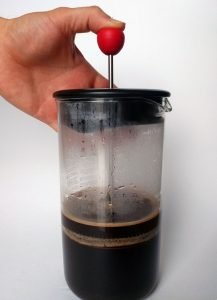
You must be logged in to post a comment.